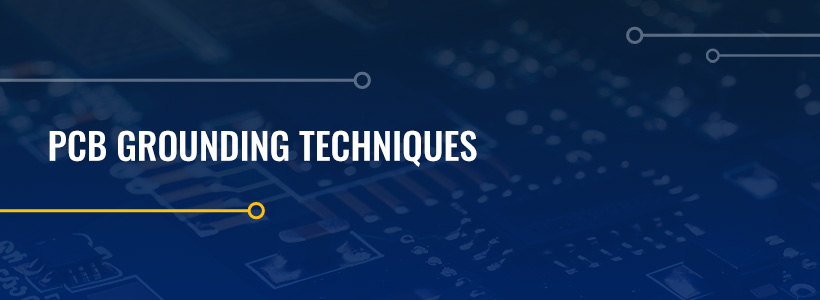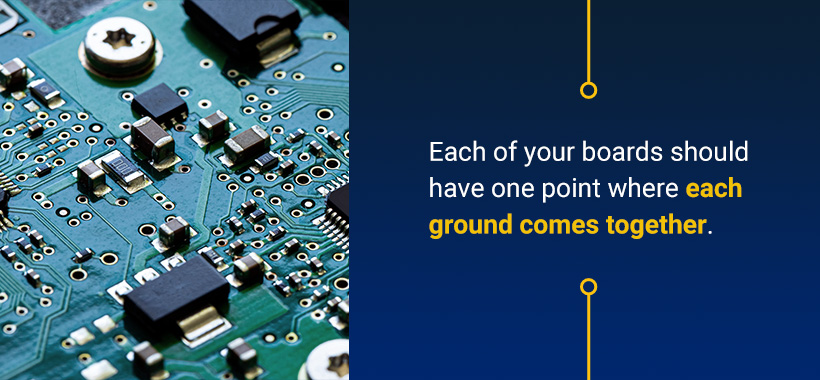Updated on January 15, 2025
Table of Contents
- What Is Ground in a Circuit?
- Common PCB Ground Types to Note
- Circuit Board Grounding Techniques
- Designing a Power Supply Layout
Grounding is crucial for any system with an electrical current, including printed circuit boards (PCBs). PCBs are critical components for most electronic devices, and they require proper grounding to ensure device function. Additionally, proper grounding is crucial for ensuring safe system use, especially in high-density and high-power boards that could otherwise face electrical hazards like interference and unwanted noise.
Although grounding strategies vary depending on PCB layout requirements, technologies, and dimensions, it’s critical to understand the importance of PCB grounding and how to choose the right method for your board.
What Is Ground in a Circuit?
A ground plane PCB component refers to the conducting body that serves as a common return for electric current and an arbitrary node of potential voltage. An electrical ground has two primary jobs:
- The first job is to provide a universal “zero” point for all electrical components to measure from — every component has an acceptable range of voltage it wants to operate in, measured from a baseline. A common voltage range for PCB components is 0 to 5 volts. Without a ground, components could be operating at a “true” voltage of 10 to 15 or -6 to -1 volts.
- The second job is that it acts like a charge sink. If you apply a voltage difference to it, it needs to be able to accept that charge almost immediately and not backfeed it into other components.
Proper grounding is essential for system function and aids in ensuring signal integrity, thermal management, and adverting electromagnetic issues.
Common PCB Ground Types to Note
There is no one-size-fits-all approach to grounding a PCB. You must understand your unique system needs and current flows to determine the best type of ground to implement. Various PCB ground types include:
- Power ground: This ground type creates a single return path for your power signals. Typically, the power ground is DC, and you must ground it from other signals separately. Note that this type of ground can be noisy.
- Signal ground: Signal ground is the point against which you compare a signal’s voltage. This reference connects to an internal ground plane. This type of ground is specially protected and controlled, as keeping it stable and true is important for obtaining clean and accurate signals. Systems with digital and analog signals require separate ground paths for both types — mixing digital and analog grounds can cause issues with both signals.
- Virtual ground: A virtual ground is a steady reference voltage that doesn’t change in a circuit. It can act as a “signal ground” for specialty use cases. You do not connect a virtual ground to a ground plane. These nodes are in negative feedback circuits at the inverting terminal of an operational amplifier. For example, think of an op-amp feedback. The virtual ground cannot sink infinite current if the input impedance is high. Non-inverting inputs at 0 volts allow negative feedback to hold the inverting terminal at the virtual ground point to match it. This would create an unstable return for other circuits. You can use virtual grounds to analyze op-amp functionality.
- Floating ground: Floating grounds in an isolated system are reference conductors without a physical earth connection or a common ground point. This feature differentiates them from grounded systems, where the ground reference is tied to the earth, providing a stable reference point for electrical signals. Unintentional floating grounds can be considered a system fault, but some designers will implement this component for safety. Additionally, floating grounds can be advantageous in reducing ground loops.
- Earth ground: Physical connections to the earth are known as earth grounds and are the easiest and safest type of ground. Earth grounds serve as a safe return for current surplus and provide a channel to dissipate unwanted energy. Earth grounds are especially beneficial for high-voltage power supplies and large electrical systems.
Circuit Board Grounding Techniques
There are several techniques and best practices for ground PCBs. Discover some of the most common approaches below:
1. Have a Dedicated Circuit Board Ground Plane
A PCB ground plane is a copper layer that is held at the system reference value and acts as a return path. Dedicated ground planes allow controlled impedance signal routing in a stripline or microstrip configuration. Most designers place the ground plane below the signal plane to minimize the return path. Two-layer boards utilize a ground plane on the bottom layer and implement signal traces and components on the top layer.
Implementing unique ground planes for low- and high-voltage sections can minimize crosstalk and aid in maintaining signal integrity in high-density boards. Ground planes in these applications need separate connections to the power supply to segregate the sections and prevent crosstalk and noise. Large ground planes can aid in thermal management because they can serve as heat sinks to distribute the heat evenly through the PCB.
When implementing ground planes into your PCB, follow these guidelines:
- Keep ground planes uniform to improve signal integrity and minimize voltage drops.
- Reduce return paths by implementing the ground plane below the signal plane.
- Route electrical connections, or nets, to prevent intersecting, which increases electromagnetic interference (EMI).
- Achieve uniformity in planes by using a copper pour ground fill and connecting them with vias.
- Employ stitching capacitors if the signal changes ground reference.
- Place a void in the ground section when using a chassis ground.
- Isolate chassis planes if you have high return currents.
2. Prevent Ground Loops With Traces or Vias
Ground loops often occur when you have multiple current return paths resulting from a difference in ground potentials through the circuit. Generally, you should avoid creating a conductive material ring because this can make the plane more susceptible to EMI. A conductive ring serves as an inductor, and external magnetic fields can cause a ground loop electric current. Your design may feature a conductive ring if you place the ground plane over the entire bottom layer and remove electronic components.
You can avoid this issue by shortening traces and placing the ground plane to run underneath them. You’ll likely need to adjust the trace and component layouts to avoid creating these rings. You may also use more than one ground plane on a two-layer board but must connect each plane individually to prevent loops from occurring.
3. Place Bypass Capacitor Connections
Active components can generate ringing and ground bounce when multiple board components share power rail distribution. Ground bounce can occur when the voltage of several ground reference points fluctuates on the board. A common method for addressing this issue is placing a bypass capacitor on the circuit, effectively bypassing power supply noises and voltage spikes.
Placing capacitors near each device’s power supply pin helps minimize current spike impacts. Connect capacitors using larger vias and traces. This strategy reduces inductance and increases current flow. Connect each ground pin individually to the plane, and do not chain the bypass ground connections together.
4. Stay on One Routing Layer
When possible, it’s best to keep sensitive routing on one layer. This strategy helps maintain clear return paths. If you have to transition layers, use a ground transfer via next to the signal via. This method helps prevent the clear return path from becoming interrupted.
5. Always Provide a Common Ground Point
Each of your boards should have one point where each ground comes together. This is typically a metal frame or product chassis but could also be a dedicated board layer. Some teams refer to this point as “star ground” because various conductors extend from the location in a star-like pattern. For mixed-signal applications, you may need separate analog and digital power supplies with separate grounds.
6. Plan for Dynamic Variance
Multi-board systems that send ground connections between boards must account for dynamic variance. Dynamic variance is the difference between the assumed and actual circuit performance value during operation. This variance can result from environmental factors, temperature changes, improper use of components, and similar factors.
Planning for dynamic variance is especially important for applications with long-distance cables. Common-mode chokes, low-voltage differential signals, and optical isolators can help control dynamic variance.
7. Ground Lightning Protection for Safety
Employ surge and lightning protection devices in layers preceding the PCB. Devices like power isolators, air gap arresters, and gas discharge tubes are excellent for addressing this issue. These devices route voltage spikes away from electrical components and disperse them to ground. You can also implement fuses to protect from current and voltage overloads and short circuits.
8. Implement Decoupling Capacitors
Integrated circuit chips in PCBs require power for operation. These chips have pins connecting to the ground plane and an external power source. Place a decoupling capacitor between the supply and ground pins, with the opposite end of the decoupling capacitor connecting to the ground plane. This strategy helps smooth oscillations in supplied voltage.
The decoupling capacitor can provide additional current to integrated circuits through a low inductance path. You can also use this component to reduce noise and EMI.
Choose decoupling capacitors based on number, placement, and size. Typically, you should distribute capacitors across the board, placing some near the IC ground and power pins. Use similar rated capacitors for all locations. In some cases, you may want to use a combination of normal and high equivalent series resistance capacitors.
9. Minimize Series Vias Usage
Minimize the number of vias along the ground paths and send components directly to the dedicated ground plane. Utilizing many series vias creates further impedance and can result in signal integrity issues, decreased performance, and potential signal reflections, especially in high-speed signal applications. Furthermore, increasing series vias usage makes the manufacturing process much more complex than necessary, creating opportunities for future challenges and increasing potential failure points.
10. Understand How the Currents Are Flowing
One final tip to keep in mind is to understand the current flow, as this knowledge informs proper grounding. You must consider where the signal is headed and which return path it will take. Sending and return paths have the same signal, impacting power stability and ground bounce. You should also design grounding before routing to create a foundation for the routing process and ensure device integrity and functionality.
Designing a Power Supply Layout
Although many general rules for high-speed designs apply to PCB power layouts, it’s important to understand the specific elements that can impact design and function.
- Component placement: Place power components near each other to restrict noise levels during routing. While you must be mindful of manufacturability, it’s best to keep these elements as close as possible. This strategy allows you to keep traces short. When considering component placement, you should also avoid placing power components in high-speed digital routing areas. Separate distinct circuit areas from each other.
- Trace routing: Shorter power supply routing translates to less inductance building in the line, which reduces noise levels from the circuit. Use wide enough traces to handle circuit currents without risking trace burn-through.
- Power and signal integrity: A solid, dedicated plane is best for PCB ground, meaning you should employ this strategy whenever possible rather than routing it with traces. This methodology improves power and signal integrity and aids in the thermal management of higher currents. Ensure the ground plane can contain all components with the supply circuitry to create another layer of protection from EMI.
Why Trust Millennium Circuits?
Millennium Circuits is your reliable supplier for all PCB needs. Since our start in 2005, we’ve been supplying bare circuit boards to teams across industries, including automotive, datacom, telecom, defense, railway, and more.
As an ISO 9001-certified company, you can feel confident in our ability to address complex PCB challenges and deliver unique solutions for your applications. Partnering with Millennium Circuits means you can gain access to technical support, flexible lead teams, cutting-edge technologies, and an excellent price-to-value ratio.
We form long-term partnerships that help teams thrive, and our targeted approach ensures your PCBs meet specifications and exude maximum quality and consistency.
Partner With Millennium Circuits for Your PCB Needs
The Millennium Circuits team has the vast industry experience and knowledge you expect from a reliable partner. Our domestic and offshore PCB capabilities include engineering, manufacturing, and life cycle assistance, so you can always enjoy comprehensive support.
Whether you’re looking for design support, need technical expertise, source exotic materials, or want expert advice for another PCB-related issue, we can help. Contact us with any questions or request a quick quote to get started with our team today.




